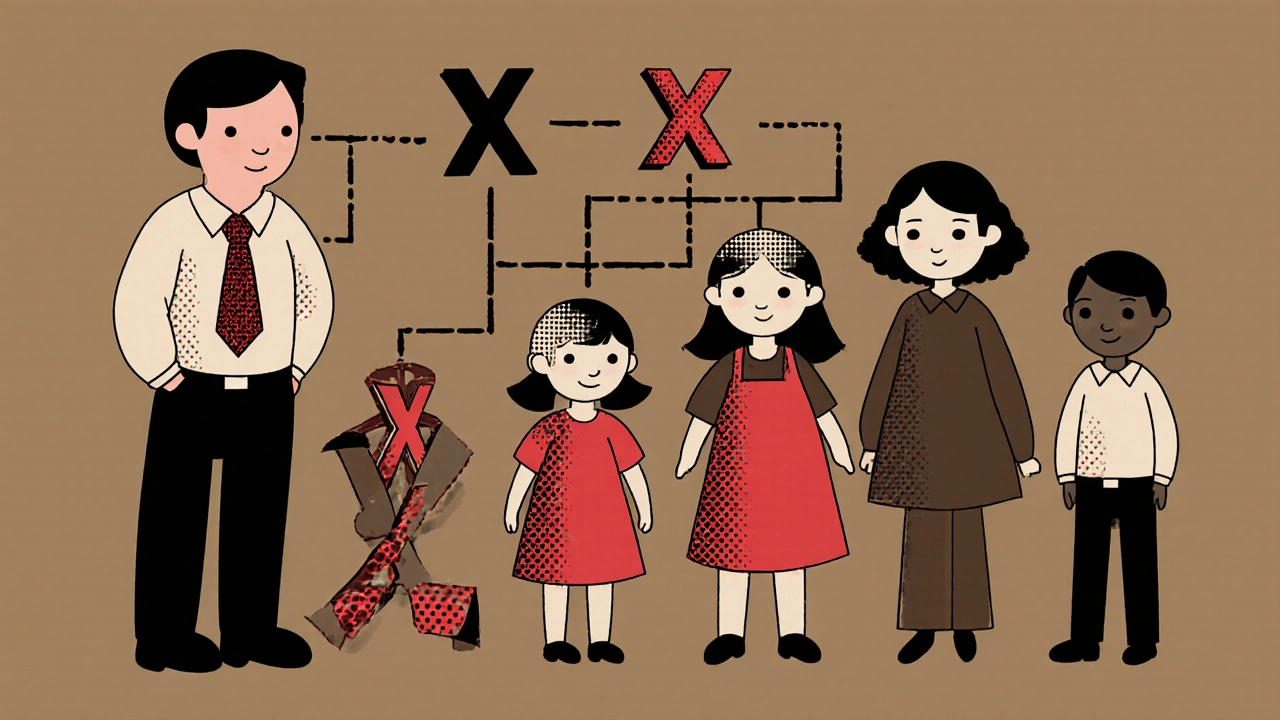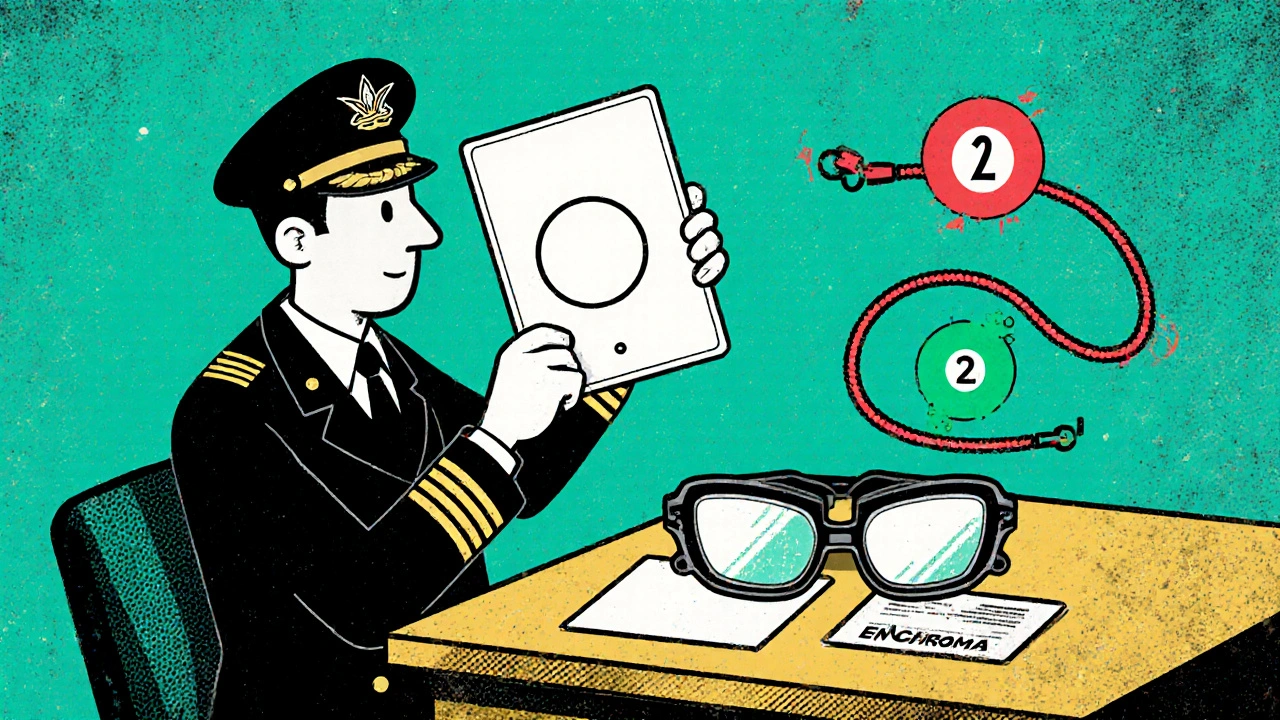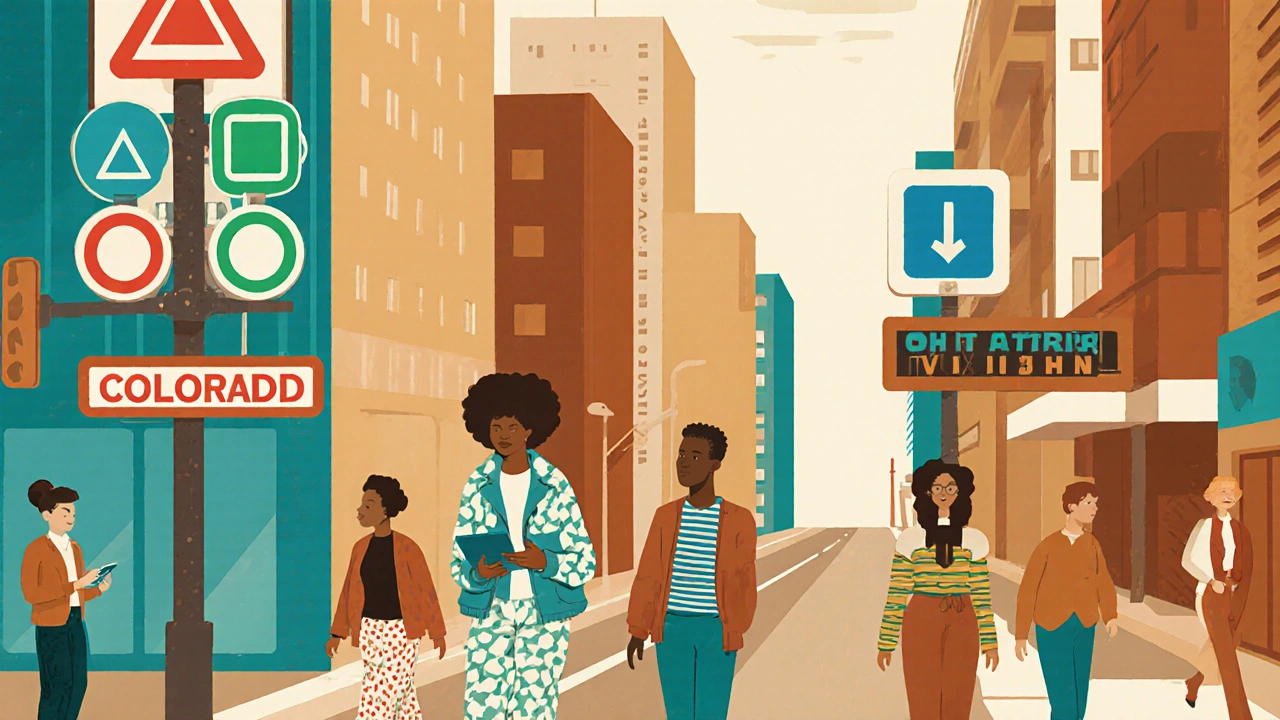
Most people think of color blindness as seeing the world in black and white. But for the vast majority of those affected, it’s not about missing color entirely-it’s about struggling to tell red and green apart. This isn’t a rare oddity. About 8% of males and 0.5% of females worldwide live with red-green color blindness, making it the most common type of color vision deficiency. And it’s not something you develop later in life-it’s written into your genes from birth.
How Red-Green Color Blindness Actually Works
Your eyes have three types of cone cells that detect color: one for red, one for green, and one for blue. The red and green cones are controlled by genes on your X chromosome. These genes make proteins called photopsins that react to light. When they work properly, you see a full spectrum. When they’re faulty or missing, your brain gets confused between reds, greens, browns, and oranges.
There are two main forms of red-green color blindness: protanopia and deuteranopia. Protanopes lack the red cone pigment entirely. Deuteranopes lack the green one. A less severe version-protanomaly and deuteranomaly-means the pigments are there but don’t work right. Deuteranomaly is the most common, affecting about 5% of men. People with this condition don’t see the world in grayscale. They just mix up colors that look very similar to them, like maroon and green, or peach and pink.
It’s not a vision problem like nearsightedness. Your sharpness, depth perception, and night vision are usually perfect. You just see colors differently. That’s why many people don’t realize they’re color blind until they’re tested-or until they make a mistake, like picking the wrong wire in an electrical panel or misreading a traffic light in fog.
Why Men Are Much More Likely to Be Affected
The reason men are nearly 16 times more likely to have red-green color blindness than women comes down to biology. The genes for red and green vision are on the X chromosome. Men have one X and one Y chromosome. Women have two X chromosomes.
If a man inherits a faulty gene on his single X chromosome, he has no backup. He’ll be color blind. But a woman needs to inherit two faulty copies-one from each parent-to be affected. If she has only one bad copy, she’s a carrier. She usually sees colors normally but can pass the gene to her children.
This is why the math works out the way it does. If 8% of men are affected, that means about 8% of X chromosomes in the population carry the mutation. For a woman to be affected, both of her X chromosomes need the mutation. That’s 8% of 8%, or about 0.64%. In reality, it’s closer to 0.5% because of how X chromosomes randomly switch off in female cells-a process called X-inactivation. That’s why you rarely see women with full color blindness, even when their fathers are affected.
How It’s Passed Down in Families
Here’s how it actually plays out in families:
- A color-blind father will pass his faulty X chromosome to all his daughters-but none of his sons. His sons get his Y chromosome, not the X.
- A carrier mother (with one faulty gene) has a 50% chance of passing it to each child. If she passes it to a son, he’ll be color blind. If she passes it to a daughter, the daughter will be a carrier.
- If a color-blind man has a daughter with a woman who isn’t a carrier, all his daughters will be carriers, and none of his sons will be affected.
- If a carrier woman has a son, there’s a 50% chance he’ll be color blind. If she has a daughter, there’s a 50% chance she’ll be a carrier.
That’s why you’ll often see color blindness skip generations. A grandfather passes it to his daughter (who doesn’t show symptoms), and she passes it to her son. The pattern looks random, but it’s predictable once you understand the X-linked inheritance.

What It Feels Like in Real Life
For many, it’s not a disability-it’s just how they see the world. But there are real challenges.
One man, a commercial pilot applicant, was disqualified because he couldn’t pass the standard color test-even though his vision was 20/20. Another, an electrician, relies on numbered wire labels instead of color codes. A graphic designer learned to use brightness and patterns instead of color alone, which actually improved her designs.
Surveys show that 78% of people with red-green color blindness struggle with color-coded school materials. 65% have trouble with traffic lights in poor weather. 42% say apps and websites are hard to use when information is only shown in color.
And then there’s the social stuff. A 2022 survey found that 37% of people with color blindness have been embarrassed by mismatched clothes. Imagine wearing a red shirt with brown pants and thinking you look fine-only to be told it looks like a mistake. It’s not about fashion. It’s about not knowing you’re seeing something differently.
Testing and Diagnosis
The most common test is the Ishihara test. It’s made of colored dots that form numbers. People with normal color vision see one number. Those with red-green deficiency see a different number-or nothing at all.
But the Ishihara test isn’t perfect. It can miss mild cases. More advanced tests like the Farnsworth-Munsell 100 Hue Test or the anomaloscope (which lets you match colors by adjusting brightness) give a clearer picture. These are used in medical settings and for jobs where color accuracy matters-like aviation, electrical work, or graphic design.
Most people aren’t tested unless they’re applying for a job or a school program that requires it. Many live their whole lives without knowing they’re affected.
Tools and Adaptations That Help
There’s no cure-but there are tools that make life easier.
EnChroma glasses, introduced in 2012, cost between $329 and $499. They don’t restore normal color vision. But for about 80% of people with red-green deficiency, they make colors pop in a way that feels more distinct. A 2023 update to their lenses improved results for deuteranomaly by 30%.
For digital accessibility, tools like Color Oracle (free) and Sim Daltonism (paid) let designers see how their apps look to color-blind users. Adobe Photoshop has a free plugin called Colorblindifier that’s been downloaded over 45,000 times.
Big tech companies have built in color filters. Apple’s iOS has had them since 2014. Microsoft’s Windows 10 has them too. Over 2.3 million people have used Microsoft’s filter. That’s not a small number-it’s millions of people adapting their tech to fit how they see.
And then there’s ColorADD, a system developed in Portugal that uses simple shapes to represent colors. A triangle is red. A circle is green. A square is blue. It’s now used in public transit systems in 17 countries, on clothing tags, and in school materials. It’s not about fixing vision-it’s about designing around it.

What the Future Holds
Science is making progress. In 2022, researchers gave gene therapy to adult squirrel monkeys with red-green color blindness-and restored their full color vision for over two years. That’s huge. It proves the brain can learn to use new color signals, even as an adult.
The National Eye Institute is funding research to bring this to humans. It’s not going to happen tomorrow. But the goal is clear: one day, a simple injection could restore normal color vision for those born with the deficiency.
In the meantime, accessibility is improving. The Web Content Accessibility Guidelines (WCAG 2.1) now require websites to use patterns, labels, and contrast-not just color-to convey information. The European Union’s Accessibility Act makes this mandatory for public services. And in the UK, the Equality Act 2010 recognizes color blindness as a disability that requires workplace accommodations.
So while you can’t change your genes, you can change how the world adapts to you. And that’s where real progress is happening.
Common Myths About Color Blindness
- Myth: Color blind people see only in black and white. Truth: Only about 1 in 30,000 people have true monochromatic vision. Most see color-they just don’t distinguish red and green well.
- Myth: Color blindness gets worse with age. Truth: It’s genetic and stable. If you’re born with it, you’ll have it your whole life. It doesn’t get worse.
- Myth: Only men can be color blind. Truth: Women can be affected, but it’s rare. They need two faulty genes.
- Myth: Glasses can cure it. Truth: They help some people see better, but they don’t fix the biology. Think of them like hearing aids for color.
What You Can Do
If you think you or someone you know might be color blind:
- Take a free online test like the Ishihara or Color Blind Check (many are available). They’re not medical-grade, but they can point you in the right direction.
- If you’re a parent, ask your child’s doctor to screen for it during routine eye checks. It’s not always part of standard exams.
- If you’re a designer, teacher, or developer, use accessibility tools. Add patterns to charts. Use labels. Don’t rely on color alone.
- If you’re affected, know that you’re not broken. You’re just wired differently. Millions of people live full, successful lives with this condition.
Color blindness isn’t a tragedy. It’s a variation. And with better awareness, better tools, and better design, the world is finally catching up.
Can color blindness be cured?
There is no cure for inherited red-green color blindness. It’s caused by genetic differences in the cone cells of the eye, and those can’t be changed with medication or surgery today. However, specialized glasses like EnChroma can help some people distinguish colors better. Gene therapy has restored color vision in monkeys, and human trials are being planned-but it’s still years away from being widely available.
Can women be color blind?
Yes, but it’s rare. Women need to inherit the faulty gene from both parents to be affected. Since the gene is on the X chromosome, and men only have one, it’s much more common in men. About 0.5% of women have red-green color blindness, compared to 8% of men. Most women who carry the gene don’t show symptoms but can pass it to their children.
Is color blindness genetic?
Yes, red-green color blindness is almost always inherited. It’s passed down through the X chromosome in an X-linked recessive pattern. The genes responsible (OPN1LW and OPN1MW) control the photopigments in red and green cone cells. Mutations or deletions in these genes cause the deficiency. Rare cases can be caused by injury or disease, but those are not inherited.
Can color blindness affect your career?
Yes, in some fields. Pilots, electricians, firefighters, graphic designers, and certain military roles require accurate color discrimination. Many countries have standards that screen for color vision in these jobs. But accommodations are possible. Labeling wires, using pattern-based systems like ColorADD, or relying on technology like color filters can help. The law in places like the UK and EU requires employers to make reasonable adjustments.
Do color-blind glasses really work?
They work for many, but not everyone. EnChroma and similar lenses filter specific wavelengths of light to increase contrast between red and green. Studies show about 80% of users report improved color discrimination, especially in outdoor settings. But they don’t restore normal color vision. They’re not a cure. And they don’t help people with complete absence of red or green cones (dichromats) as much as those with milder forms (anomalous trichromats).
How do you test for color blindness?
The most common test is the Ishihara test, which uses colored dots to form numbers. More detailed tests include the Farnsworth-Munsell 100 Hue Test and the anomaloscope, which lets you match colors by adjusting brightness. These are used in clinical settings. Online tests are available but aren’t always accurate. For medical diagnosis, see an optometrist or ophthalmologist who specializes in color vision.




Gabriella Jayne Bosticco
November 18, 2025 AT 00:05I never realized how many daily things rely on color until I started noticing my brother struggling with traffic lights in the rain. He’s always been fine with everything else-driving, cooking, even art-but those red-green signals? Total guesswork. I used to think he was just being careless. Turns out he’s been navigating a different world this whole time. It’s wild how much we take for granted.
Katelyn Sykes
November 18, 2025 AT 13:03As a graphic designer I used to rely on color combos like it was gospel until I ran a simulation and realized half my clients couldn’t tell the difference between my ‘highlight’ and ‘background’ colors. Now I use patterns, borders, labels-my designs are cleaner and more accessible. Honestly it made me better at my job. Also EnChroma glasses? Game changer for outdoor shoots. 🙌
Gabe Solack
November 19, 2025 AT 02:02My dad’s color blind. He used to get mad at my mom for buying him ‘brown’ socks that were actually red. Then he got EnChroma glasses and cried in the grocery store because he saw ‘red’ apples for the first time. Not a cure but damn if it doesn’t feel like one. Still doesn’t help with his terrible fashion sense though 😅
Yash Nair
November 20, 2025 AT 12:00Why do you even care about this? In India we dont have time for this western nonsense. We have real problems like poverty and corruption. Why waste energy on some eye thing? Also this EnChroma stuff is just a scam by Americans to sell overpriced glasses. Everyone knows colorblind people just need to try harder
Bailey Sheppard
November 21, 2025 AT 17:02This is one of the most thoughtful breakdowns of color blindness I’ve ever read. I didn’t realize how much design and infrastructure still ignores this. The part about ColorADD in public transit? Brilliant. Simple, elegant, no tech needed. We need more of this kind of thinking-not just in design but in education too. Thanks for writing this.
Girish Pai
November 22, 2025 AT 03:29From a neurogenetic perspective, the X-linked recessive inheritance model is textbook Mendelian, but the phenotypic expression variance due to X-inactivation in females is often underappreciated. The mosaicism caused by lyonization results in variable expressivity even among carriers, which explains the 0.5% prevalence versus the theoretical 0.64%. Also, the photopsin gene cluster on Xq28 has high homology leading to unequal crossover events-hence the high mutation rate in OPN1LW/OPN1MW.
Kristina Williams
November 22, 2025 AT 05:41They don’t want you to know this but color blindness is caused by 5G radiation and the CDC is hiding the truth. The government uses these color tests to track who’s ‘different’ and flag them for surveillance. That’s why they made the Ishihara test so confusing-so you won’t notice you’re being watched. Also EnChroma glasses? They’re implanted with microchips. Don’t buy them. Trust me I read it on a forum.
Sarah Frey
November 22, 2025 AT 09:28It is profoundly important to recognize that color vision deficiency is not a deficit, but rather a variation in human perception that has been historically pathologized. The social and institutional barriers faced by individuals with this condition-particularly in professional contexts-represent a failure of inclusive design rather than an individual limitation. The integration of non-color-dependent cues in public infrastructure and digital interfaces is not merely an accommodation; it is an ethical imperative aligned with principles of universal design and human rights.
Shilpi Tiwari
November 24, 2025 AT 05:42Interesting! The OPN1MW gene duplication events in primates are actually a relatively recent evolutionary adaptation-estimated at 30-40 million years ago. The fact that humans retained this trichromatic system while most mammals are dichromatic suggests strong selective pressure, likely related to frugivory and detecting ripe fruit against foliage. But the high prevalence of mutations in the red-green opsin genes implies a low functional constraint-maybe because color isn’t as critical for survival in modern environments? Still, the persistence of these alleles suggests possible heterozygote advantage in certain contexts. Fascinating.